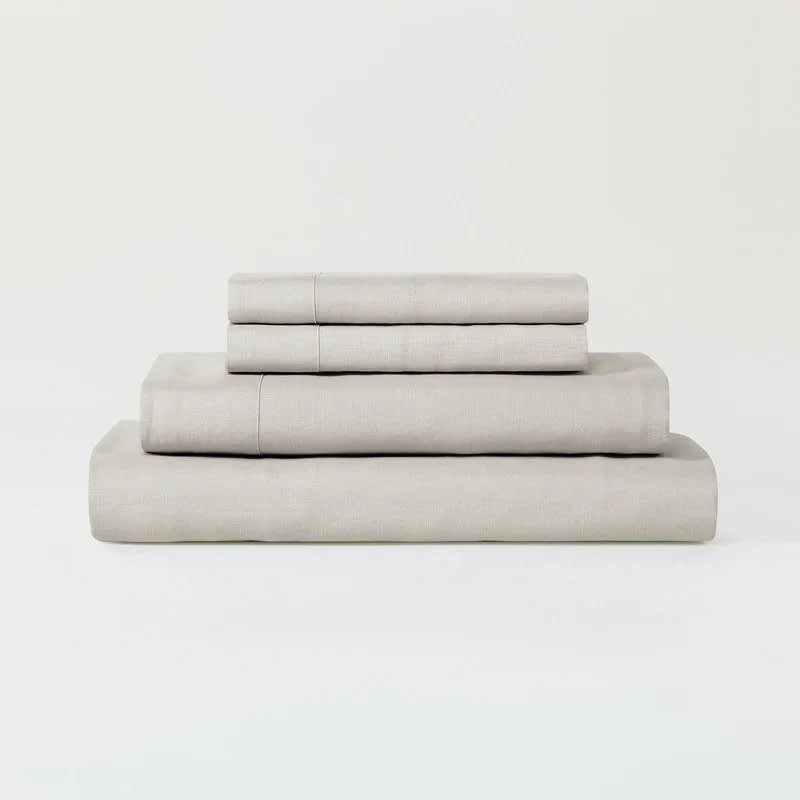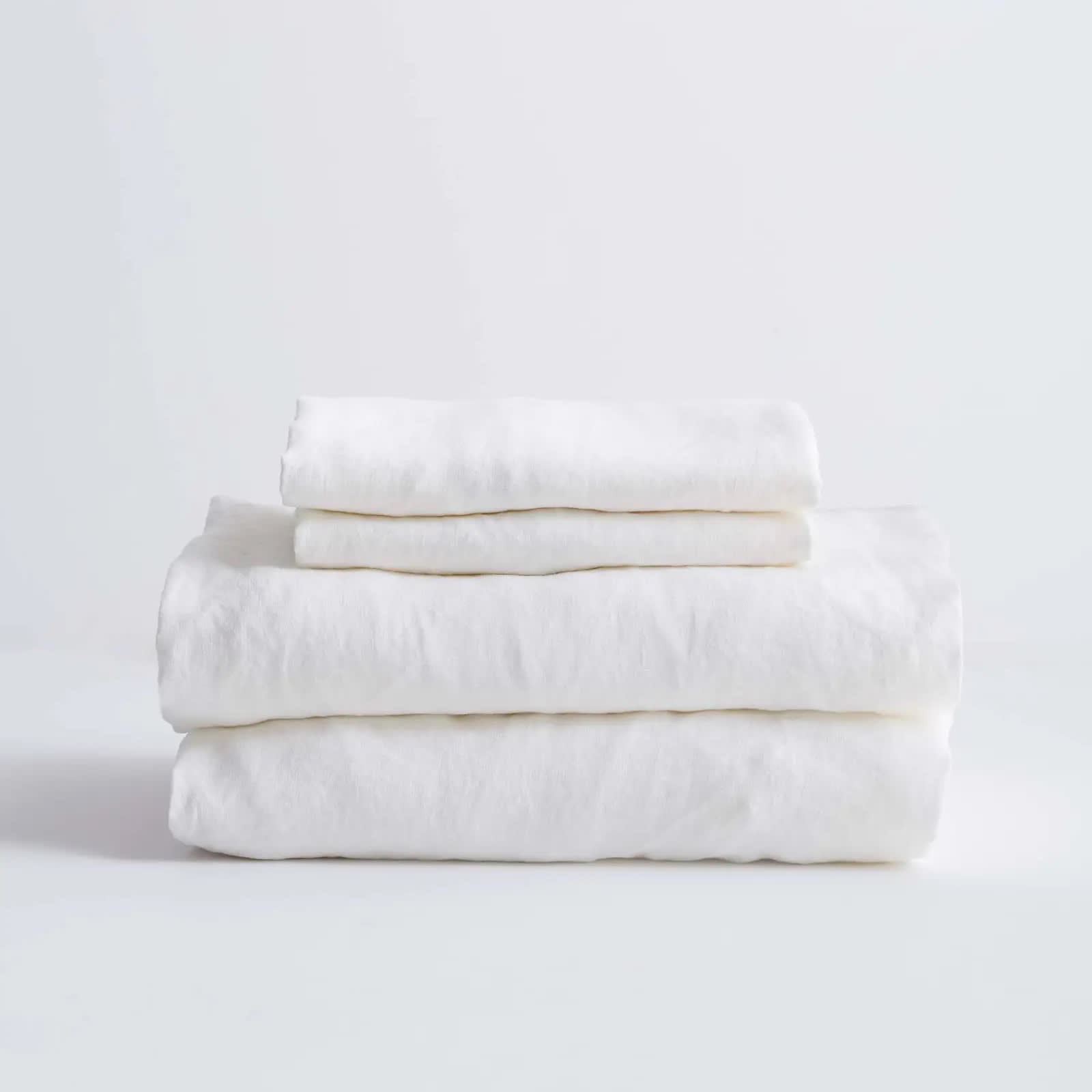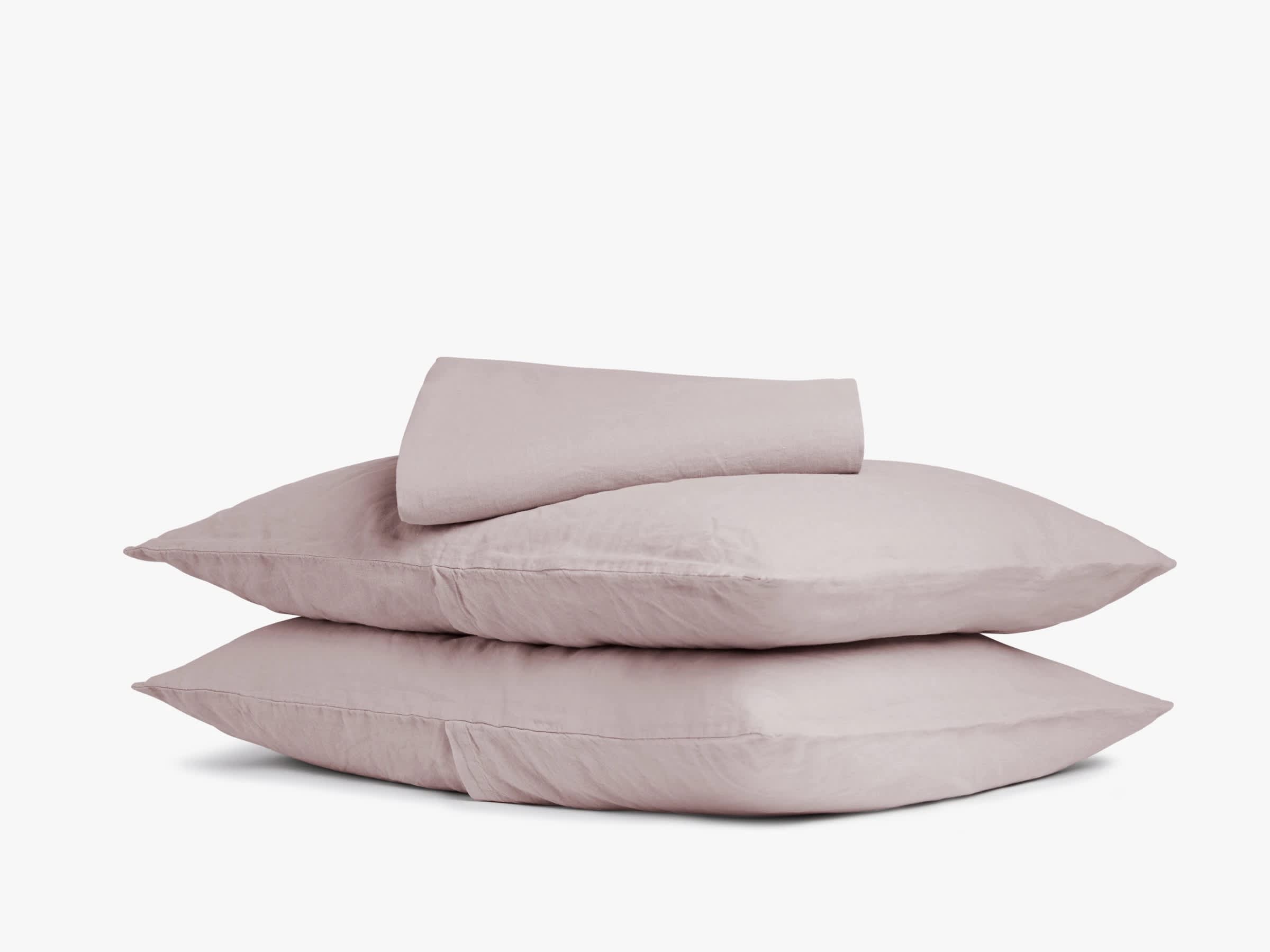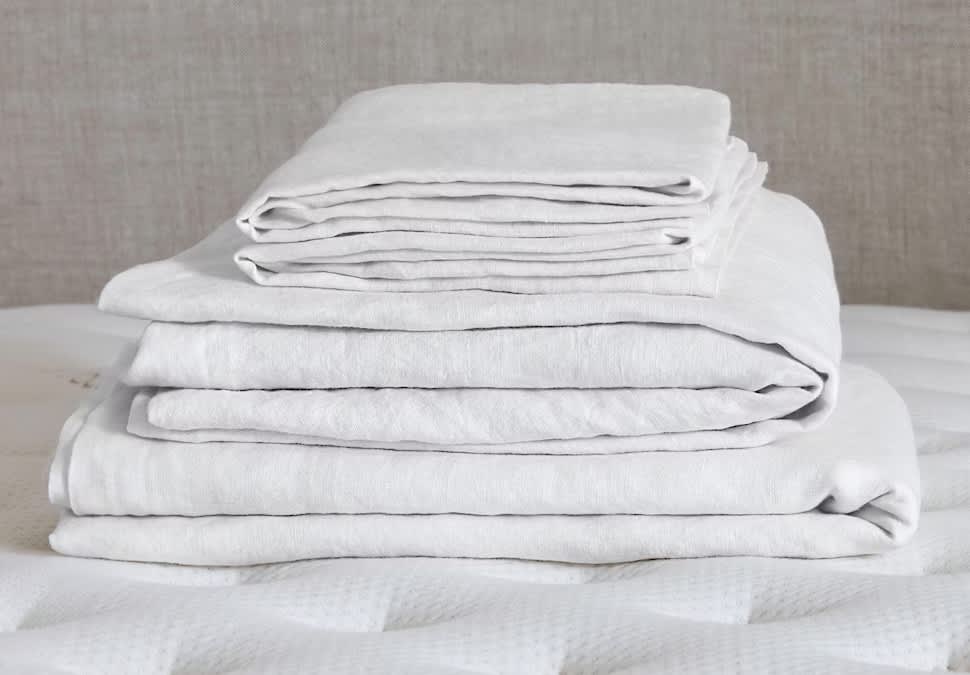On This Page
The Best Linen Sheets of 2025
Our Top Picks
-
Best Overall
Sijo LuxeWeave Linen Sheet Set -
Best Value
Quince European Linen Sheet Set -
Most Comfortable
Saatva Linen Sheet Set -
Best All-Season
Parachute Linen Sheet Set
Best Overall

Our testers found that the Sijo LuxeWeave Linen Sheet Set delivered everything we love about linen sheets, from exceptional durability to versatile temperature regulation.
Pros & Cons
Pros
- Stonewashed to maximize softness from day one
- Sourced from small-batch French flax
- Available for purchase internationally
Cons
- Limited color options
- Doesn’t come with a warranty
Full Details
How Does It Feel?
Why We Like It
Best Value

Our testers were impressed by the softness and quality of the weave found in the Quince European Linen Sheet Set.
Pros & Cons
Pros
- 100% linen from European flax at a competitive price
- Sustainably sourced and manufactured
- Wide variety of color and design options
Cons
- Not available in stores
- Currently unavailable outside the U.S.
Full Details
How Does It Feel?
Why We Like It
Most Comfortable
Pros & Cons
Pros
- Linen from 100% Belgian flax
- Great for hot sleepers
- Yarn-dyed for lasting color
Cons
- Limited color choices
- Price could be out of reach for budget-conscious shoppers
Full Details
How Does It Feel?
Why We Like It
Best All-Season

While linen is known for its temperature neutrality, our testers were still impressed by how well the Parachute Linen Sheet Set performed in both warm and cold temperatures.
Pros & Cons
Pros
- Made from durable 100% European flax
- Envelope enclosure on pillow cases
- Very breathable and moisture-wicking
Cons
- Price-point could be a barrier for some
- No warranty
Full Details
How Does It Feel?
Why We Like It
How We Test
When we test linen sheets, we try them personally in our Seattle sleep lab and our homes. First, we look at the linen’s weave, quality, and overall feel. We also research the linen’s origins and production because those factors are a good indication of overall quality. We lie on every sheet set to get a feel for their comfort and breathability, which are important if you’re considering linen bedding.
Before making a recommendation, we also check existing customer reviews to see what current owners think of their sheets. Getting information from verified reviews can help us understand how sheets hold up long-term, especially when it comes to laundering, pilling, and general durability.
What Are Linen Sheets?
Linen is a versatile, comfortable and long-lasting material with numerous natural benefits. In fact, widespread use of linen dates back thousands of years and the fabric remains a popular choice today for clothing, bedding, and home decor.
Linen is derived from fibers of the flax plant, which are spun into yarn and then woven or knitted into fabric. Linen sheets start out crisp, but soften with each subsequent wash cycle. Well-used linen sheets have a luxurious, airy feel with a subtle texture and structured drape.
Linen sheets are exceptionally durable and can withstand regular use and laundering while resisting pilling, which many believe justifies their higher price-point compared to cotton and other fabrics.
Who Is a Good Match for Linen Sheets?
Many sleepers choose linen sheets because the material is durable, breathable, and easy to care for. Besides its practical benefits, many sleepers are fond of linen’s rustic look.
- Sleepers who prefer crisp, light sheets: Linen has a unique, crisp texture that softens over time. Sheets made from linen feel lightweight and breathable compared to other fabrics.
- Hot sleepers and those who live in warmer climates: Linen has excellent airflow and moisture-wicking ability, keeping sleepers cool and dry throughout the night.
- Shoppers who are interested in durable, eco-friendly sheets: Compared with other materials, linen is exceptionally durable. Since growing flax requires little water and irrigation, linen tends to take less energy to produce than other fabrics and is a good choice for eco-conscious shoppers.
Linen is one of those magic fibers that can actually get softer as you wash it. Investing in a high-quality set might cost more to begin with, but it’s probably going to save you money in the long run because you can use them longer before having to buy a replacement.
Why Buy Linen Sheets?
Compared to other fabrics, linen offers exceptional temperature regulation, a unique and luxurious feel, and unrivaled durability. Since this fabric is also eco-friendly and hypoallergenic, many sleepers find that linen sheets are worth the investment.
Pros and cons of linen sheets
While linen sheets offer numerous advantages, they are not for everyone. Before deciding on the best sheets for you, we suggest evaluating the pros and cons of different materials and considering them in relation to your unique needs and preferences.
Pros
- Extremely durable
- Remarkable temperature regulation
- High-end look
Cons
- High price-point
- Wrinkle easily
- Texture can feel stiff
What to Expect From Linen Sheets
Linen sheets are unique for a number of reasons, from their crumpled appearance to their crisp feel. Therefore, it’s important to familiarize yourself with their characteristics before making a purchase.
| Linen sheets characteristics | Description |
| Feel | Linen sheets begin lightweight and crisp, but soften with use and regular washing as the fiber breaks in. Some sheets come prewashed or stonewashed to give them a light feel from day one. |
| Thread count / Weight | Unlike other materials, high thread count is not an indicator of quality for linen. Weight, which is measured in grams per square meter (GSM), is a better indicator of how linen sheets feel and perform. |
| Breathability | Linen is revered for its natural breathability, meaning it disperses heat and wicks away moisture from the body. |
| Durability | Linen is one of the most durable natural fabrics available, and has a longer lifespan than materials like cotton and polyester. |
| Ease of care | Most linen is machine washable, dryer-friendly, and simple to care for. |
| Price | Linen sheets tend to be higher priced than sheets made from fabrics like cotton and polyester. |
Are Linen Sheets Better Than Cotton Sheets?
Linen sheets offer superior cooling properties, making them better than cotton sheets for hot sleepers. Linen’s long fibers and loose weave offer natural breathability and moisture-wicking abilities. Additionally, linen sheets are highly durable, surpassing cotton sheets in longevity. While linen may initially feel coarser, it softens with each wash.
While linen softens with use, those looking for a smooth initial texture may prefer cotton sheets. Cotton sheets are more wrinkle-resistant and are generally available in more colors and patterns. Linen sheets have a minimum price-point that is still relatively high, while cotton sheets are available at a wide variety of prices.
I find that linen is a great option for hot sleepers like me. Linen sheets are really airy and some sets are pretty effective at wicking moisture away from your body too.
How Are Linen Sheets Made?
Linen comes from the fibers of flax plants. These fibers are separated from the plant before being spun into yarn. The result is a thread that is considerably thicker than that of cotton, which can then be woven or knitted into linen fabric, often at a specialized mill.
Best Thread Count for Linen Sheets (What Is GSM?)
Since linen fibers are thicker than cotton, high thread count is not a good indication of quality when shopping for linen sheets. For this reason, manufacturers often don’t specify the thread count of linen products. In general, linen fabrics have a thread count between 80 and 150, whereas fine cotton weaves are generally between 200 and 400.
The weight of linen gives a better idea of its feel. Weight is measured in grams per square meter (GSM), with lighter weight indicating a thinner fabric suitable for summer and heavier weight indicating sheets that can be used year-round. Most linen sheets fall between 150 and 190 GSM, with 150 GSM considered mid-weight and 180 to 190 GSM indicating heavier fabric.
Pure Linen vs. Linen Blends
Pure linen is known for its distinct texture and crumpled look, but sometimes manufacturers blend in other materials that can affect these characteristics. In general, linen blends are priced lower than pure linen.
- Linen/cotton blend: When cotton is blended with linen, the result is a smoother, softer fabric that is less wrinkly, but also less durable and potentially prone to shrinking.
- Linen/bamboo-derived viscose blend: When linen is blended with bamboo-derived fabrics, the resulting material is often only 20% to 30% linen. These fabrics tend to be slightly stiffer than bamboo-derived fabrics, emphasizing the silky smoothness of rayon or viscose derived from bamboo.
-
Linen/polyester blend: Sheets made from a linen and polyester blend are smoother, and less prone to wrinkles. However, the addition of synthetic materials make them less eco-friendly and not as breathable as pure linen fabrics.
| What’s so special about European linen sheets? |
| European flax is grown in a large coastal area of Western Europe that offers a unique combination of environmental factors that help produce some of the strongest fibers in the world. As an example, Belgian Linen is known worldwide for its quality. European flax is grown without the need for irrigation, GMOs, or fertilizers. Thus, most linen sheets made with European flax are certified by OKEO-TEX or GOTS as being sustainable and free of a broad range of chemicals. There is also a European Flax Certification which validates the textile’s traceability through every step of the process and guarantees local farming committed to zero irrigation, zero GMO use, and zero waste. |
Last Things to Know About Linen Sheets
Linen sheets are a great choice for sleepers looking for a durable and cool bedding set that’s easy to care for. When shopping for sheets, remember to consider your personal preferences, including your budget and how you want the sheets to feel.
Are linen sheets scratchy, and do they get softer?
Some sleepers find that linen sheets are initially coarse or scratchy, but they gradually soften with washing as the fibers break down. Many linen sheet sets come prewashed or stonewashed to prevent initial roughness.
Is it easy to wash and dry linen sheets?
Caring for linen sheets is simple, as most can be washed and dried in household machines. Experts recommend that they be washed every one to two weeks. With proper care, linen sheets can last decades without pilling or significant degradation. Many consider their tendency to wrinkle part of the aesthetic, but linen sheets can be ironed as needed.
Are linen sheets naturally cooling?
Linen sheets offer excellent natural cooling properties for hot sleepers because their long fibers and loose weave promote airflow and wick away moisture.
Can linen keep you warm in colder weather?
Heavier linen performs well in cold weather because of the material’s natural ability to insulate. However, linen with a weight under 165 GSM may prove too thin for colder weather.

